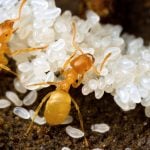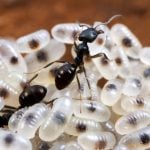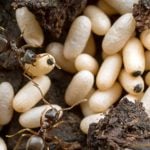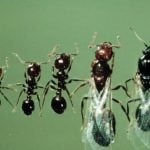Life Cycle of an Ant
The life cycle of an ant goes through four distinct phases from egg to adult ant, with subtle differences between species
Eggs
Ant eggs are the first stage of the life cycle of an ant. They are tiny, at approximately 0.5 mm in diameter, and weighing about 0.0005g. They are kidney shaped and have a smooth sticky surface which enables them to bond together. This assists the adult ant to move them about more quickly. It is easier and quicker to carry many eggs in one go, rather than having to pick each individual egg up. Inside your ant farm you may see this as a cluster of tiny white dots.
Larvae
Stage 2 in the life cycle of an ant. After about 7 to 14 days of cell division the larvae will emerge from the eggs. First of all they are no bigger than the egg from which they emerged. They look very much like tiny maggots at this stage. Furthermore, as the larvae grow, they shed their skin, usually about 3 times in all, increasing in size with each moult from 1 mm to 4 mm.
With each successive moult they become hairier. Some of the hairs on the larvae are in a hook shape to enable larvae to stick together. Consequently, it makes for easier carrying. However, at the last moult the larvae are usually too heavy to hook together and subsequently are carried individually. There are some slight differences in the appearance of the larvae of various ant species. For example, some are hairier than others. They may be a more elongated than others.
The larvae have no legs, but they are capable of some very small movements, such as bending their head toward a food source. In some species, they can move along very slowly if necessary. When they feed, they suck up the juices of solid foods brought to them by the adult worker ants. Furthermore, they can receive regurgitated food from the adult ants. Larvae have large digestive glands with reservoirs that run the full length of their body, opening at the mouth.
Pupae/Cocoons
After, approximately, a further 13 to 28 days (about 8 to 12 weeks from egg to adult ant), the next stage in the development of ants is reached. This varies according to species and ambient temperatures, the adult ant emerges looking very pale and soft. Whiles a newly born Lasius niger ant is almost white at first, after a few hours it will darken and the exoskeleton will harden. Finally, it looks like the other ants in the colony.
The particular job that each worker does within the colony depends on its age. New ants tend the queen and brood within the security of the depths of the nest. As the ant gets older so it will change jobs which take it nearer the surface of the ground until, nearer the end of its life, the ant will leave the safety of the nest and forage outside. This is the most economical way of sharing out the chores among the ants.
Adult Ant
The final stage in the life cycle of an ant. After, approximately, a further 13 to 28 days (about a total of 8 to 12 weeks from egg to adult ant), the adult ant is “born”. In contrast this varies according to species and ambient temperatures. The adult ant emerges looking very pale and soft. A newly born Lasius niger ant is almost white at first, but after a few hours it will darken and its exoskeleton will harden.
The particular job that each worker does within the colony depends on its age. New ants tend the queen and brood within the security of the nest. As the ant gets older so it will change jobs which take it nearer the surface of the ground. Nearer the end of its life, the ant will leave the safety of the nest and forage outside. This is the most economical way of sharing out the chores among the ants.
Most noteworthy is the fact that it is the older ants who leave the nest, rather than the younger. In contrast this is not so much the case with first generation workers in new colonies.
The Development of Ants
The life cycle of an ant - how how the various castes of adult ants produced?
Whether it is a worker, soldier (not seen in native UK species), male or queen that develops from a particular larva depends on various factors:
Worker: Normal development and food intake as a larva.
Soldier: Increased foot intake as a larva.
Male: Develop from unfertilised eggs.
Queens: Appears to be food intake related – fed lots more food as a larva, than a worker larva receives.
One difference between ants and humans is that while humans send their young men off to war, ants send their old ladies.
– E.O Wilson (paraphrased)





Ask questions about ants
If you wish to ask me a question about ants (and no, I won’t tell you how to destroy them or their nests!) then please contact me on my**@an*****.uk or you can ask on the contact thread
I aim to respond to your questions as quickly as I can, normally within 24 hours.
